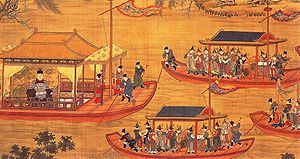List of emperors of the Ming dynasty
[3] He was viewed as the intermediary between humans and heaven and was responsible for conducting numerous rituals to honor the supreme deities who safeguarded the empire.
During audiences, his subjects were expected to demonstrate their submission by prostrating themselves before him,[5] although the majority of decisions were actually made by the Grand Secretariat and the ministries.
[7] The majority of the Ming emperors resided in the Forbidden City, a 72 ha (180-acre) complex of palaces and buildings in Beijing.
[8] The Ming dynasty was founded by Zhu Yuanzhang (the Hongwu Emperor), who was one of the leaders of the Red Turban peasant rebellion.
Despite humble beginnings, he successfully built his own state, defeated other rebel leaders, and forced the last Yuan emperor to flee China proper.
[15] In theory, he held ultimate authority over all officials and generals, and the entire country was expected to obey his decrees.
[18] Major issues were typically discussed at official audiences or informal meetings, and it was necessary to reach a broad consensus among court dignitaries before making any significant decisions.
[17] During the reigns of the Hongwu Emperor and his successors, China generally experienced a period of economic growth and political stability.
To defeat the rebels, Wu Sangui, the last Ming general in the northeast, invited the Manchu-led Eight Banners of the Qing dynasty to enter the Central Plains.
[21] Despite losing control of the north, members of the Ming imperial family continued to rule over southern China.
